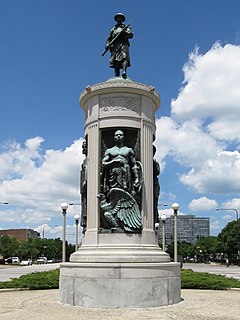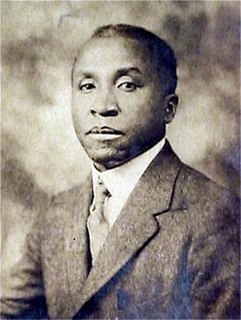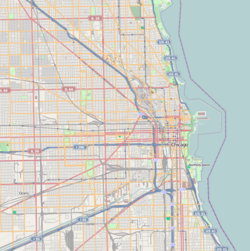
Illinois Institute of Technology is a private research university in Chicago, Illinois. Tracing its history to 1890, the present name was adopted upon the merger of the Armour Institute and Lewis Institute in 1940. The university has programs in architecture, business, communications, design, engineering, industrial technology, information technology, law, psychology, and science. It is classified among "R2: Doctoral Universities – High research activity".

Douglas, on the South Side of Chicago, Illinois, is one of 77 Chicago community areas. The neighborhood is named for Stephen A. Douglas, Illinois politician and Abraham Lincoln's political foe, whose estate included a tract of land given to the federal government. This tract later was developed for use as the Civil War Union training and prison camp, Camp Douglas, located in what is now the eastern portion of the Douglas neighborhood. Douglas gave that part of his estate at Cottage Grove and 35th to the Old University of Chicago. The Chicago 2016 Olympic bid planned for the Olympic Village to be constructed on a 37-acre (150,000 m2) truck parking lot south of McCormick Place that is mostly in the Douglas community area and partly in the Near South Side.

Grand Boulevard, located on the South Side of Chicago, Illinois, is one of the well-defined Chicago Community Areas. The boulevard from which the community area takes its name now bears the name of Martin Luther King Jr. Drive. The area is bounded by 39th to the north, 51st Street to the south, Cottage Grove Avenue to the east, and the Chicago, Rock Island & Pacific Railroad tracks to the west.

State Street is a large south-north street, also one of the main streets, in Chicago, Illinois, USA and its south suburbs. Its intersection with Madison Street has marked the base point for Chicago's address system since 1909. State begins in the north at North Avenue, the south end of Lincoln Park, runs south through the heart of the Chicago Loop, and ends at the southern city limits, intersecting 127th Street along the bank of the Little Calumet River. It resumes north of 137th Street in Riverdale and runs south intermittently through Chicago's south suburbs until terminating at New Monee Road in Crete, Illinois.

The Jefferson Market Branch of the New York Public Library, once known as the Jefferson Market Courthouse, is a National Historic Landmark located at 425 Avenue of the Americas, on the southwest corner of West 10th Street, in Greenwich Village, Manhattan, New York City, on a triangular plot formed by Greenwich Avenue and West 10th Street. It was originally built as the Third Judicial District Courthouse from 1874 to 1877, and was designed by architect Frederick Clarke Withers of the firm of Vaux and Withers.

Erected in 1927, the Victory Monument, created by sculptor Leonard Crunelle, was built to honor the Eighth Regiment of the Illinois National Guard, an African-American unit that served in France during World War I. It is located in the Black Metropolis-Bronzeville District in the Douglas community area of Chicago, Illinois. The structure was added to the National Register of Historic Places on April 30, 1986. It was designated a Chicago Landmark on September 9, 1998. An annual Memorial Day ceremony is held at the monument.

The Chicago Defender Building is the former Jewish synagogue that housed the Chicago Defender from 1920 until 1960. It was designated a Chicago Landmark on September 9, 1998. The building is in the Black Metropolis-Bronzeville District in the Douglas community area of Chicago, Illinois at 3435 S. Indiana Ave. It was designed by Henry L. Newhouse. You can read more about the nine designated landmarks, including the Chicago Defender Building and Robert S. Abbott, the newspaper's publisher, in this document from the City of Chicago Department of Planning and Development, The Black Metropolis - Bronzeville District.

Black Metropolis–Bronzeville District is a historic African American district in the Bronzeville neighborhood of South Side, Chicago, Illinois.

Wabash Avenue YMCA is a Chicago Landmark located within the Chicago Landmark Black Metropolis-Bronzeville Historic District in the Douglas community area of Chicago, Illinois. This YMCA facility served as an important social center within the Black Metropolis area, and it also provided housing and job training for African Americans migrating into Chicago in the early 20th century. In 1915, the Association for the Study of Negro Life and History, one of the first groups specializing in African-American studies, was founded at YMCA.

The Robert S. Abbott House is a historic house in the Grand Boulevard community area of Chicago, Illinois. Built about 1900, it was home from 1926 until his death of Robert S. Abbott (1870-1940), founder and publisher of the Chicago Defender, the largest-circulation African-American newspaper in the nation. Abbott started this newspaper in 1905 in which he heartened blacks in southern United States to move into north far from racist south. Abbott became one of the few self-made black millionaires in the early 20th century. His home was designated a National Historic Landmark status in 1976.

Hygienic Manufacturing Company, also known as Overton Hygienic Company, was a cosmetics company established by Anthony Overton. It was one of the nation's largest producers of African-American cosmetics. Anthony Overton also ran other businesses from the building, including the Victory Life Insurance Company and Douglass National Bank, the first nationally chartered, African-American-owned bank. The Overton Hygienic Building is a Chicago Landmark and part of the Black Metropolis-Bronzeville District in the Douglas community area of Chicago, Illinois. It is located at 3619-3627 South State Street.

Quinn Chapel AME Church, also known as Quinn Chapel of the A.M.E. Church, houses Chicago's oldest African-American congregation, formed by seven individuals as a nondenominational prayer group that met in the house of a member in 1844. In 1847, the group organized as a congregation of the African Methodist Episcopal Church, the first independent black denomination in the United States. They named the church for Bishop William Paul Quinn.

The Eighth Regiment Armory, located in the Black Metropolis-Bronzeville District of Chicago, Illinois, was the first armory in the United States built for an African-American military regiment, known as the "Fighting 8th". The building later was used by a division of the Illinois National Guard, and during World War I was incorporated into the US Infantry. After closing the armory in the early 1960s, it became the South Central Gymnasium. In 1999, following an extensive renovation, it was reopened as a public high school military academy. The restoration and conversion into a school has been recognized by the National Trust for Historic Preservation.

The South Side is an area of Chicago. It is the largest of the three Sides of the city that radiate from downtown—the others being the North Side and the West Side.

The South Side Community Art Center is a community art center in Chicago that opened in 1940 with support from the Works Progress Administration's Federal Art Project in Illinois. Opened in Bronzeville, it became the first black art museum in the United States and has been an important center for the development Chicago's African American artists. Of more than 100 community art centers established by the WPA, this is the only one that remains open.
Anthony Overton Jr., a banker and manufacturer, was the first African American to lead a major business conglomerate.

Walter Thomas Bailey was an American architect from Kewanee, Illinois. He was the first African American graduate with a bachelor of science degree in architectural engineering from the University of Illinois at Urbana-Champaign and the first licensed African-American architect in the state of Illinois. He worked at the Tuskegee Institute, and practiced in both Memphis and Chicago. Walter T. Bailey became the second African American that graduated from the University of Illinois.
The Supreme Life Building is a historic insurance building located at 3501 S. Dr. Martin Luther King Drive in the Douglas community area of Chicago, Illinois. Built in 1921, the building served as the headquarters of the Supreme Life Insurance Company, which was founded two years earlier by Frank L. Gillespie. The company, originally known as the Liberty Life Insurance Company, was the first African-American owned insurance company in the northern United States. Since white-owned insurance firms regularly denied black customers life insurance when the firm was founded, the firm played an important role in providing life insurance to Chicago's African-American community. The company ultimately became the largest African-American owned business in the northern states and became a symbol of the predominantly black Bronzeville neighborhood's economic success from the 1920s to the 1950s.
The Chicago Bee or Chicago Sunday Bee was a Chicago-based weekly newspaper founded by Anthony Overton, an African American, for primarily African-American readers. The paper was committed to covering "wholesome and authentic news", and adopted a middle-class, conservative tone. Politically, it was aligned with the Republican Party.




















